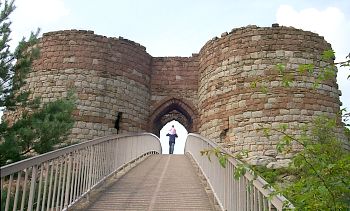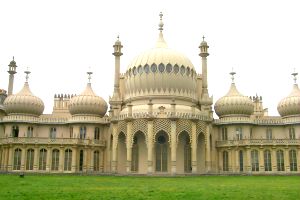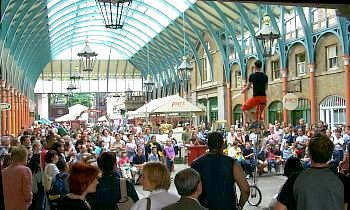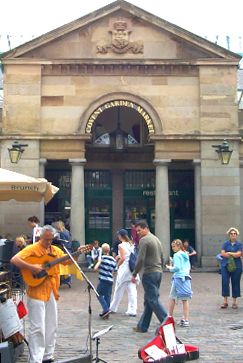Food is very important to the travel experience, since you must eat out most of the time. One of the reasons why I hesitated to visit the U.K. before was its infamous cuisine. Why eat such dull pedestrian fare as fish and chips or bangers and mash, when one can indulge in the legendary French or Italian cuisine on the continent?
But noticing the popularity of recent British cooking shows, like the Naked Chef and Ready, Steady, Cook!, I felt at last the Brits had come to appreciate creative cooking and now there would be a much greater variety of fare to choose from when eating out in the U.K.

O.K. so my first meal after landing in Liverpool was fish and chips and I had my first taste of mushy peas. But that was to be the ONLY fish and chips I had during my two week stay! I was pleasantly surprised at the diversity of cuisines now available in the larger cities in England.
Even pub food took me by surprise. It’s no longer your typical British fare, athough some traditional items are still featured on many menus especially in the countryside. I found many pubs now employ talented chefs, often trained in foreign lands, like France or Italy. Some pubs even specialize in international cuisines.
The Indian subcontinent’s influence on British taste buds has grown over the last century. So it’s no surprise that fish and chips have now been supplanted by curries and balties as the most popular British food. Indian takeaways and restaurants can now be found in almost every town in England.
Italian, French and Chinese food have always been popular in England’s larger cities, but now even the more exotic Thai, Vietnamese, Indonesian, Mexican, African and middle eastern cuisines are finding their way into the British diet. Asian food in particular is gaining ground as trendy restaurants popup everywhere, especially in London.
Vegetarians have always been welcome in England, as there is a long tradition of prominent vegetarians in their society. But finding vegetarian fare or vegan based menus has always been a challenge outside of a few major cities. But now most restaurants acknowledge the existence of those who prefer not to eat meat, and offer a wider range of veggie selections on their menus. In addition the number of vegetarian restaurants has blossomed, and now they can be found in smaller cities around the isles. I was particularly impressed with the selection of veggie restaurants in Brighton.
One major weak spot in British fare that is changing only slowly is breads. We can thank the British for inventing the “sandwich”, but you’d think by now they’d realize there’s more than white bread to eat with it. Whole grain breads are starting to appear here and there, but aren’t as well established as on the continent. The traditional English “toast” is still made with square pieces of white bread, which now comes in opaque plastic bags so you can’t even view it in the markets. And yes, I did see people eating beans on toast and spaghetti on toast, or just plain dry toast. Come on folks, let’s try some other breads for a change! I did find some bagels and tortillas at Tesco’s. So I guess there’s hope after all!
The most exciting food experience I had in England was a visit to Harrod’s food courts. If you visit London, this is an absolute must! The incredible displays of food are legendary, with beautiful sculptures highlighting vast quantities of fresh produce, fish, meats and much more. I wish I could’ve taken pictures to show you, but photography is prohibited in the store. There are various cafes and bars where you can sit and partake of the extraordinary tempting delights prepared to order (quite pricey). I found their bakery to be excellent with a wide selection of reasonably priced tasty treats .
So be prepared to give your taste buds a workout in England. The food IS good to excellent these days. And the variety is amazing. Don’t forget your traditional dishes too, as these can be very tasty, if you don’t mind the meat and grease.






 If you’re looking for fun in London, get down to Covent Garden, the center of London’s theater and entertainment district. There’s lots of trendy alternative shops, markets, music, and restaurants in this area to explore. Much of the area is closed to traffic, so walking around is easy. Window shopping is choice in this district with many specialty shops selling things like rare books, art, shoes, and the latest fashions. Just wander around the maze of short streets. Don’t miss Neal Street and James Street, as these are the alternative places to shop. James Street will take you right to the Covent Garden Market.
If you’re looking for fun in London, get down to Covent Garden, the center of London’s theater and entertainment district. There’s lots of trendy alternative shops, markets, music, and restaurants in this area to explore. Much of the area is closed to traffic, so walking around is easy. Window shopping is choice in this district with many specialty shops selling things like rare books, art, shoes, and the latest fashions. Just wander around the maze of short streets. Don’t miss Neal Street and James Street, as these are the alternative places to shop. James Street will take you right to the Covent Garden Market. But still it’s a wonderful place to hangout on a nice day. In summer there’s live entertainment including music, magic, juggling or performance art. Now every month, on the second Friday, there’s a fresh produce market specializing in seasonal and organic produce!
But still it’s a wonderful place to hangout on a nice day. In summer there’s live entertainment including music, magic, juggling or performance art. Now every month, on the second Friday, there’s a fresh produce market specializing in seasonal and organic produce! London’s famed Underground, the oldest subway in the world, opened in 1863. Also referred to as “The Tube”, the Underground is one of the best ways to get around London quickly and cheaply. If you’re planning to visit a number of attractions in one day, the best way to go is to get a Travelcard for the day which allows unlimited travel through all four city zones for only £5, for the day.
London’s famed Underground, the oldest subway in the world, opened in 1863. Also referred to as “The Tube”, the Underground is one of the best ways to get around London quickly and cheaply. If you’re planning to visit a number of attractions in one day, the best way to go is to get a Travelcard for the day which allows unlimited travel through all four city zones for only £5, for the day.  It’s also valid on buses, trams and the rail service to the suburbs. This can be a good bargain if your travel takes you to the outskirts of the city where it can cost £1.90 for a one-way. It also saves you from having to queue up for tickets over and over.
It’s also valid on buses, trams and the rail service to the suburbs. This can be a good bargain if your travel takes you to the outskirts of the city where it can cost £1.90 for a one-way. It also saves you from having to queue up for tickets over and over.